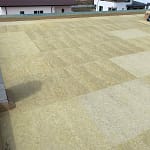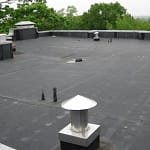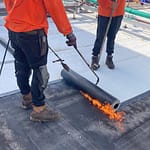Bituminous roofing is one of the most popular materials due to its durability and resistance to various climatic conditions. It provides good protection against moisture, is easy to install and is suitable for various types of roofs. Bituminous coating is often used due to its flexibility, so it adapts well to complex roof shapes.
bitumen roofing
Bituminous roofing is a popular solution for both residential and commercial roofs due to its reliability, durability and resistance to various climatic conditions. This coating is made of bitumen, which gives the roof excellent resistance to water and weather changes, ensuring long-term protection against moisture. In addition, it tolerates temperature fluctuations well, so it is suitable for both warm and cold climates.
One of the main advantages of bituminous coating is easy installation, as it is flexible and can be adapted to complex roof shapes. It is an ideal choice not only for flat but also for sloping roofs. Bituminous roofing also has good thermal insulation, helping to reduce energy costs. Due to these features, it is often chosen as an economical, reliable and long-lasting solution to protect the building from environmental influences.

Bitumen roofing: What is it and why should you choose it?
Roofing is one of the most important stages of the construction process, which determines the durability, comfort and energy efficiency of the building. Not only the resistance of the roof to environmental influences, but also thermal insulation, ease of operation and aesthetic appearance depend on the selected roof covering. Bituminous roofing is one of the most popular solutions for both residential and commercial buildings.
In this article, we will discuss in detail the advantages, disadvantages, installation process and other important features of bituminous roofing, which will help you understand why bituminous roofing is a reliable and often chosen solution. We will also review the types of bituminous coating and how to choose the correct coating according to the type of roof and the specifics of the building.
What is Bituminous Roofing?
Bituminous roofing is a roofing material made from bitumen, a material derived from petroleum, with waterproofing properties and resistance to environmental influences. It is often used for roofing due to its resistance to moisture, temperature fluctuations and ultraviolet (UV) rays. Bituminous coatings can be of various forms, due to the suitability of the properties of the roll coating for covering different types and shapes of roofs.

Rolled bituminous coating
Mostly used for flat roofs. It is an elastic material that provides excellent waterproofing and long-term weather protection.

Modified bitumen membranes
An improved version of bitumen, which uses polymer additives that help improve resistance to temperature fluctuations and increase the elasticity of the coating.
Advantages of bituminous roofing
When choosing a roof covering, it is important to evaluate not only the price, but also other important aspects, such as resistance to environmental conditions, ease of installation, aesthetic appearance and maintenance. Bituminous roofing has many advantages, which is why it has become widely used all over the world.
Water and weather resistance
One of the main advantages of bituminous coating is its excellent waterproofing properties. Bitumen is naturally resistant to moisture, so the roof effectively protects the building from precipitation, be it rain, snow or ice. Also, this coating perfectly resists temperature changes, maintaining its elasticity and not losing its properties in extreme conditions - both in heat and cold.
Longevity
A properly installed and maintained bituminous roof covering can last for several decades. Due to its resistance to UV rays and mechanical damage, bitumen maintains its structure and functionality for a long time. In the case of residential buildings, bituminous tiles can last up to 30-50 years, depending on the environmental conditions and the intensity of maintenance.
Flexibility and adaptability to various roof shapes
The bituminous coating is elastic, so it perfectly adapts to complex roof shapes, uneven surfaces or unconventional architectural solutions. This is especially relevant in cases where atypical or very intricately shaped roofs need to be covered.
Good thermal insulation
The bituminous roof covering has good thermal insulation, which helps reduce heat loss in winter and prevents overheating in summer. This can reduce energy costs for space heating or cooling.
Sound insulation
Bituminous coating, especially in rolls or with ceramic granules, effectively dampens external noise. This is especially true for those who live near heavy traffic or in noisy urban areas.
Economical solution
Bituminous roofing is relatively inexpensive, and its durability and minimal maintenance can save you money in the long run. They do not require complex maintenance work or expensive repairs, and installation is simple and fast.
Bituminous roofing installation: how is it done?
Installation of bituminous roofing depends on the chosen type of coating. Rolled roofing is usually laid on flat or low-sloped roofs, while bituminous tiles are installed on sloping roofs. The installation process is usually carried out in several stages:
Preparation
Before laying the coating, it is necessary to prepare the base of the roof. It must be smooth, clean and dry. If the roof is uneven or has remnants of the old coating, they must be removed or the base leveled.
Insulation laying
In order to ensure good thermal insulation, the base of the roof is covered with insulating material. It can be mineral wool or polystyrene panels, which help reduce heat loss and improve energy efficiency.
Bituminous coating installation
The roll bituminous coating is laid on the prepared base and fixed using a hot air blower or special adhesives. When installing bituminous tiles, they are fixed with nails or staples. It is important to ensure that the coating is properly reinforced so that there are no gaps through which moisture can enter.
Additional works
After installing the bituminous coating, you need to take care of the water drainage system - gutters and downspouts. Also, if the roof has a more complex shape, it may be necessary to install additional layers of sealing around chimneys, skylights or other difficult areas.
Maintenance of bituminous coating
Although the bituminous coating requires minimal maintenance, it is worth periodically inspecting the roof in order to notice potential defects in time. It is important to keep the roof clean of debris, leaves and other contaminants that can clog the drainage system.


we recommend planting bituminous roofs
Green roofs are roofs installed on buildings where vegetation is grown. They provide many advantages: they help improve the urban microclimate, reduce air pollution, insulate heat and reduce energy costs. Green roofs also help regulate the flow of rainwater, reduce the risk of flooding and contribute to the preservation of biodiversity in cities. In addition, they create an aesthetic environment where people can relax or even grow food. Read why we suggest choosing to green the roof.






